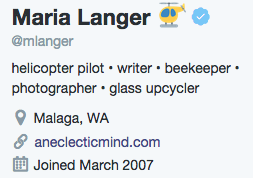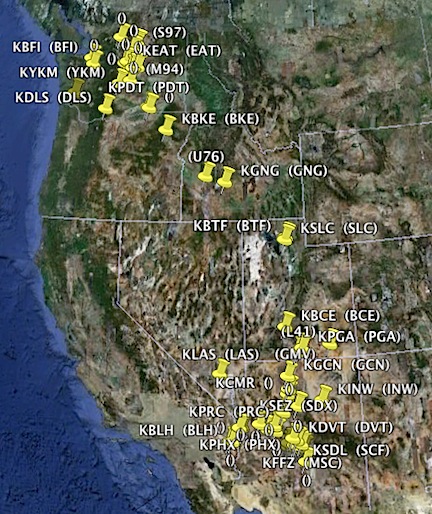Interesting how a tiny blue check mark can make people take you more seriously.

That tiny blue checkmark means I’m really who I say I am. (The helicopter is an emoji and appears in red everywhere except my profile page when I’m logged in on my Mac. Go figure, huh?)
About a month ago, I requested that my Twitter account be “verified.” It was the second time I’d made the request — the first time was at least five years ago, not long after verification began — and although I’d been turned down the first time, I was verified the second. I got the coveted blue checkmark beside my name.
The skinny on verification
Verified Twitter accounts are those accounts that Twitter has verified as belonging to the person whose name appears on the account. This is so that people looking for the real account in question know they’ve found it.
To get verified status, you need to be somewhat “famous” or at least publicly known for something. I’m known for a few things: I wrote computer how-to books for more than 20 years, I’ve owned a helicopter charter business for more than 15 years, I’ve been blogging for more than 13 years, I’ve been recording video training courses for more than 10 years (including several about Twitter), and I currently write articles for a variety of aviation publications. When I filled in the forms online and submitted the documents to prove that I really was who I said I was and that I was worthy of verification, the folks at Twitter apparently agreed. Without any fanfare, the blue checkmark appeared on my Profile page.
I actually noticed a side effect to verification before I noticed the checkmark: literally overnight, I gained about 100 followers. That was weird.
The benefits of the blue checkmark
Being verified gives you some additional benefits the average Twitter user just doesn’t have.

As amazing as it seems to me, during this particular 24-hour period, my tweets were displayed 123,514 times.
First of all, you get a bit more respect. Is it possible that I’m seeing fewer trolls? It sure seems that way. (Of course, I do block all the trolls I encounter, so I don’t see repeat offenders.)
Next, it gets your tweets more attention. People are more likely to read a tweet when the account it came from is verified. I’m seeing that in my stats. My tweets are getting seen, retweeted, and liked more than ever.

This tweet, which I shot out in response to Donald Trump’s whining about protesters (see below for embedded tweet), has become immensely popular.
@realDonaldTrump Are you fucking kidding me? Suck it up president-elect.
— Maria Langer �� (@mlanger) November 11, 2016
Of course, I like to think that this particular tweet has become so popular because it’s so witty. Honestly who knows? (And who cares?)
Twitter also gives verified users additional tools for monitoring notifications. An additional tab appears on my notifications page so I can view a list of All, Mentions, and Verified. The Verified option shows me only notifications from other verified accounts. I can imagine this being extremely useful for truly famous people who want to weed out the mere mortals. Personally, I don’t use it much, although a surprising number of other verified users do interact with my tweets. I have to wonder if that’s because I’m verified, too.
Behavioral changes
Has being verified changed the way I use Twitter? Possibly.
First of all, I don’t think I tweet any more or less than I have during the more than nine years I’ve been using Twitter. I currently average 10 to 20 tweets a day, with a total of about 61,600 total tweets since March 2007.
That said, I’m definitely more cognizant that the things I tweet may be seen by far more people. Although I’m usually very careful about what I post online — I’m not an idiot, like a certain small-handed, thin orange skinned president-elect who can’t seem to keep his tweet hole shut, thus exposing his fragile narcissistic ego to the world — I do think twice about how what I tweet might affect my brand.
Yes, I did say “brand.” That’s because being a verified Twitter user helps establish your name (or account name) as a brand. I already had a brand that was relatively strong in the early 2000s. Who knows? It might become strong again. I don’t want to tweet anything that can hurt it.
What do you think?
Does the verified badge on a Twitter account affect the way you follow or interact with that account?
Are you a verified Twitter user? Have you noticed a difference in the way Twitter works for you?
I’m curious. Use the comment link form to share your thoughts about this.
And please — let’s not go off on tangents about the election. Haven’t you had enough of that in the news? I sure have.


 My flights are spread out over the entire year, with February, March, September, and October my busiest months. LogTen Pro created this graph for me so I could visualize it.
My flights are spread out over the entire year, with February, March, September, and October my busiest months. LogTen Pro created this graph for me so I could visualize it. I landed at 52 different places in Arizona, California, Nevada, Utah, Idaho, Oregon, and Washington. 16 of these landing zones were off-airport, although two of them were official helipads registered with the FAA. These numbers do not include about a dozen off-airport landing zones I used during one mine survey job in March; it just wasn’t worth logging them all. This Google Earth map shows where they were, using data from LogTen Pro. (Seriously: isn’t this cool?)
I landed at 52 different places in Arizona, California, Nevada, Utah, Idaho, Oregon, and Washington. 16 of these landing zones were off-airport, although two of them were official helipads registered with the FAA. These numbers do not include about a dozen off-airport landing zones I used during one mine survey job in March; it just wasn’t worth logging them all. This Google Earth map shows where they were, using data from LogTen Pro. (Seriously: isn’t this cool?)

